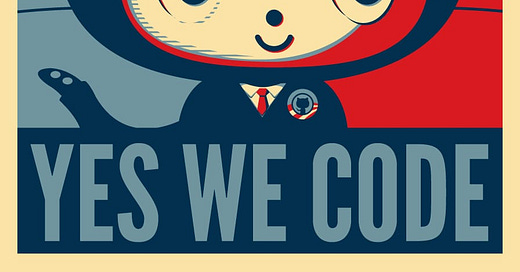GitHub: Revolutionizing Collaborative Software Development from Open-Source Roots to Microsoft Acquisition
GitHub is one of the most popular platforms for version control and collaborative software development. Its story begins with the rise of Git, an essential tool in the world of software development.
Origins of Git
Before delving into GitHub, it's important to understand Git. Git is a distributed version control system created by Linus Torvalds in 2005. Torvalds, the creator of the Linux operating system kernel, developed Git to better manage the development of Linux. At the time, the Linux development team was using a proprietary system called BitKeeper. When licensing issues arose between the team and BitKeeper in 2005, Torvalds decided to build a new, open-source version control system that could meet the needs of a large, distributed development team. Thus, Git was born, known for its speed, efficiency, and ability to track changes to code across multiple collaborators.
The Birth of GitHub
In 2008, Tom Preston-Werner, Chris Wanstrath, PJ Hyett, and Scott Chacon founded GitHub as a platform that would allow developers to store their Git repositories and collaborate on code more easily. The founders wanted to create a user-friendly interface for Git that would make the powerful version control system accessible to more people, especially those who were not comfortable using the command line.
- Tom Preston-Werner had already been using Git for his own projects and saw the potential for a platform that could make version control easier for teams of developers.
- Chris Wanstrath and PJ Hyett, who were working on Ruby on Rails projects at the time, were also attracted to the idea of creating a simple, social platform for code collaboration.
- Scott Chacon, who later wrote the popular book *Pro Git*, contributed his deep expertise with Git and helped make GitHub's technical side robust.
Together, they launched GitHub in April 2008. From the outset, it was designed to be a social platform for developers, where users could "fork" projects, submit "pull requests," and collaborate in an open-source manner. These features were all built on top of Git's existing infrastructure, but GitHub added a new layer of usability and social interaction.
Growth and Features
GitHub grew quickly, thanks to the booming demand for collaborative coding tools in the software development world. Developers loved how easy it made version control and project collaboration. Over the years, GitHub introduced several important features:
1. GitHub Pages (2008): This feature allowed developers to host simple websites from their GitHub repositories, a useful tool for project documentation or showcasing personal work.
2. Organizations (2010): GitHub introduced support for companies and groups of developers with the addition of "Organizations," allowing them to create shared repositories.
3. Pull Requests (2008): GitHub’s pull request feature became one of its most popular, as it allowed for streamlined code review and discussion around proposed changes.
4. Issues and Project Management: GitHub integrated tools for issue tracking, milestones, and project management, making it more than just a code repository.
By 2012, GitHub had over 1 million users and hosted millions of repositories. Its growth was fueled by the increasing adoption of open-source development as well as its use by private companies for internal projects.
GitHub’s Acquisition by Microsoft
In 2018, GitHub announced that it had been acquired by Microsoft for $7.5 billion in stock. The acquisition was met with mixed reactions from the developer community, as Microsoft had previously been seen as an antagonist to the open-source movement. However, under CEO Satya Nadella, Microsoft had shifted its stance, embracing open source more actively with projects like Visual Studio Code, Azure, and its use of Linux in various products.
After the acquisition, Nat Friedman, a former CEO of Xamarin, became the CEO of GitHub. Under his leadership, GitHub continued to thrive and expand its services, including the integration with Microsoft’s development tools and cloud platforms like Azure.
Modern GitHub
GitHub remains a cornerstone of the software development world, used by individuals, small teams, and large enterprises alike. It introduced GitHub Actions in 2019, allowing for automation of workflows directly within the platform. GitHub Copilot, an AI-powered code suggestion tool built on OpenAI’s Codex, was released in 2021, bringing machine learning assistance to the development process.
Today, GitHub continues to be the largest host of source code in the world, with millions of developers using it daily for version control, code collaboration, and project management. Its core mission—to make it easier to build software collaboratively—remains unchanged.
Key Figures in GitHub's Creation
1. Tom Preston-Werner: Co-founder of GitHub, created Jekyll (used for GitHub Pages), and contributed significantly to GitHub's early vision and product development.
2. Chris Wanstrath: Co-founder and former CEO of GitHub, he guided the company through its rapid growth phase and was instrumental in establishing it as the go-to platform for developers.
3. PJ Hyett: Co-founder and CTO of GitHub in its early days, played a critical role in building the platform’s infrastructure.
4. Scott Chacon: Git expert and co-founder, who shaped the technical side of GitHub and authored Pro Git, an influential book for developers.
GitHub's blend of social interaction, ease of use, and robust Git integration has made it a cornerstone of modern software development, reshaping how developers work together across the globe.




